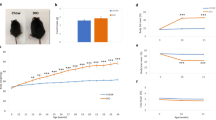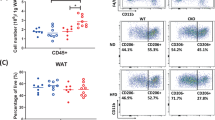Abstract
Background and Objective:
We have previously demonstrated that gamma tocotrienol (γT3) potently inhibits adipocyte hyperplasia in human adipose-derived stem cells (hASCs). In this study, our objective was to investigate the γT3 effects on early-onset obesity, inflammation and insulin resistance in vivo.
Methods:
Young C57BL/6J mice were fed a high-fat (HF) diet supplemented with 0.05% γT3 for 4 weeks. The concentrations of γT3 in plasma and adipose tissue were measured using high-performance liquid chromatography. Effects of γT3 on body weight gain, adipose volume, plasma levels of fasting glucose, insulin (enzyme-linked immunosorbent assay (ELISA)), proinflammatory cytokines (mouse cytokine array), insulin signaling (western blotting) and gene expression (quantitative real-time PCR, qPCR) in the liver and adipose tissue were examined. Influences of γT3 on [3H]-2-deoxyglucose uptake and lipopolysaccharide (LPS)-mediated NFκB signaling (western blotting) were assessed in hASCs. Effects of γT3 on macrophage M1/M2 activation were investigated using qPCR in mouse bone marrow-derived macrophages.
Results:
After a 4-week treatment, γT3 accumulated in adipose tissue and reduced HF diet-induced weight gain in epididymal fat, mesenteric fat and the liver. Compared with HF diet-fed mice, HF+γT3-fed mice were associated with (1) decreased plasma levels of fasting glucose, insulin and proinflammatory cytokines, (2) improved glucose tolerance and (3) enhanced insulin signaling in adipose tissue. There were substantial decreases in macrophage specific markers, and monocyte chemoattractant protein-1, indicating that γT3 reduced the recruitment of adipose tissue macrophages (ATMs). In addition, γT3 treatment in human adipocytes resulted in (1) activation of insulin-stimulated glucose uptake and (2) a significant suppression of MAP kinase and NFκB activation. In parallel, γT3 treatment led to a reduction of LPS-mediated M1 macrophage polarization.
Conclusion:
Our results demonstrated that γT3 ameliorates HF diet-mediated obesity and insulin resistance by inhibiting systemic and adipose inflammation, as well as ATM recruitment.
This is a preview of subscription content, access via your institution
Access options
Subscribe to this journal
Receive 12 print issues and online access
$259.00 per year
only $21.58 per issue
Buy this article
- Purchase on Springer Link
- Instant access to full article PDF
Prices may be subject to local taxes which are calculated during checkout






Similar content being viewed by others
References
Nesaretnam K, Meganathan P . Tocotrienols: inflammation and cancer. Ann N Y Acad Sci 2011; 1229: 18–22.
Ju J, Picinich SC, Yang Z, Zhao Y, Suh N, Kong AN et al. Cancer-preventive activities of tocopherols and tocotrienols. Carcinogenesis 2010; 31: 533–542.
Matough FA, Budin SB, Hamid ZA, Abdul-Rahman M, Al-Wahaibi N, Mohammed J . Tocotrienol-rich fraction from palm oil prevents oxidative damage in diabetic rats. Sultan Qaboos Univ Med J 2014; 14: e95.
Yuen KH, Wong JW, Lim AB, Ng BH, Choy WP . Effect of mixed-tocotrienols in hypercholesterolemic subjects. Funct Foods Health Dis 2011; 3: 106–117.
Manu KA, Shanmugam MK, Ramachandran L, Li F, Fong CW, Kumar AP et al. First evidence that g-tocotrienol inhibits the growth of human gastric cancer and chemosensitizes it to capecitabine in a xenograft mouse model through the modulation of NF-kB pathway. Clin Cancer Res 2012; 18: 2220–2229.
Qureshi AA, Qureshi N, Wright JJ, Shen Z, Kramer G, Gapor A et al. Lowering of serum cholesterol in hypercholesterolemic humans by tocotrienols (palmvitee). Am J Clin Nutr 1991; 53: 1021S–1026S.
Zhao L, Ha J-H, Okla M, Chung S . Activation of autophagy and AMPK by gamma-tocotrienol suppresses the adipogenesis in human adipose derived stem cells. Mol Nutr Food Res 2014; 58: 569–579.
Uto-Kondo H, Ohmori R, Kiyose C, Kishimoto Y, Saito H, Igarashi O et al. Tocotrienol suppresses adipocyte differentiation and Akt phosphorylation in 3T3-L1 preadipocytes. The J Nutr 2009; 139: 51–57.
Wu SJ, Huang GY, Ng LT . g-Tocotrienol induced cell cycle arrest and apoptosis via activating the Bax-mediated mitochondrial and AMPK signaling pathways in 3T3-L1 adipocytes. Food Chem Toxicol 2013; 59: 501–513.
Ima-Nirwana S, Suhaniza S . Effects of tocopherols and tocotrienols on body composition and bone calcium content in adrenalectomized rats replaced with dexamethasone. J Med Food 2004; 7: 45–51.
Fang F, Kang Z, Wong C . Vitamin E tocotrienols improve insulin sensitivity through activating peroxisome proliferator-activated receptors. Mol Nutr Food Res 2010; 54: 345–352.
Wong WY, Poudyal H, Ward LC, Brown L . Tocotrienols reverse cardiovascular, metabolic and liver changes in high carbohydrate, high fat diet-fed rats. Nutrients 2012; 4: 1527–1541.
Jiang Q, Rao X, Kim CY, Freiser H, Zhang Q, Jiang Z et al. Gamma-tocotrienol induces apoptosis and autophagy in prostate cancer cells by increasing intracellular dihydrosphingosine and dihydroceramide. Int J Cancer 2012; 130: 685–693.
Xu W, Du M, Zhao Y, Wang Q, Sun W, Chen B . g-Tocotrienol inhibits cell viability through suppression of b-catenin/Tcf signaling in human colon carcinoma HT-29 cells. J Nutr Biochem 2012; 23: 800–807.
Greenberg AS, Obin MS . Obesity and the role of adipose tissue in inflammation and metabolism. Am J Clin Nutr 2006; 83: 461S–465S.
Weisberg SP, McCann D, Desai M, Rosenbaum M, Leibel RL, Ferrante AW . Obesity is associated with macrophage accumulation in adipose tissue. J Clin Invest 2003; 112: 1796–1808.
Xu H, Barnes GT, Yang Q, Tan G, Yang D, Chou CJ et al. Chronic inflammation in fat plays a crucial role in the development of obesity-related insulin resistance. J Clin Invest 2003; 112: 1821–1830.
Kanda H, Tateya S, Tamori Y, Kotani K, Ki Hiasa, Kitazawa R et al. MCP-1 contributes to macrophage infiltration into adipose tissue, insulin resistance, and hepatic steatosis in obesity. J Clin Invest 2006; 116: 1494–1505.
Mills C . M1 and M2 macrophages: oracles of health and disease. Crit Rev Immunol 2012; 32: 463–488.
Labonte AC, Tosello-Trampont AC, Hahn YS . The role of macrophage polarization in infectious and inflammatory diseases. Mol Cells 2014; 37: 275–285.
Lumeng CN, Bodzin JL, Saltiel AR . Obesity induces a phenotypic switch in adipose tissue macrophage polarization. J Clin Invest 2007; 117: 175–184.
Qureshi AA, Reis JC, Papasian CJ, Morrison DC, Qureshi N . Tocotrienols inhibit lipopolysaccharide-induced pro-inflammatory cytokines in macrophages of female mice. Lipids Health Dis 2010; 9: 143.
Wang Y, Jiang Q . g-Tocotrienol inhibits lipopolysaccharide-induced interlukin-6 and granulocyte colony-stimulating factor by suppressing C/EBPb and NF-kB in macrophages. J Nutr Biochem 2013; 24: 1146–1152.
Ahn KS, Sethi G, Krishnan K, Aggarwal BB . g-Tocotrienol inhibits nuclear factor-kB signaling pathway through inhibition of receptor-interacting protein and TAK1 leading to suppression of antiapoptotic gene products and potentiation of apoptosis. J Biol Chem 2007; 282: 809–820.
Abuasal B, Thomas S, Sylvester PW, Kaddoumi A . Development and validation of a reversed-phase HPLC method for the determination of g-tocotrienol in rat and human plasma. BiomedChromatogr 2011; 25: 621–627.
Abe C, Ikeda S, Uchida T, Yamashita K, Ichikawa T . Triton WR1339, an inhibitor of lipoprotein lipase, decreases vitamin E concentration in some tissues of rats by inhibiting its transport to liver. J Nutr 2007; 137: 345–350.
Fang X, Dong W, Thornton C, Willett KL . Benzo [a] pyrene effects on glycine N-methyltransferase mRNA expression and enzyme activity in Fundulus heteroclitus embryos. Aquat Toxicol 2010; 98: 130–138.
Chung S, Lapoint K, Martinez K, Kennedy A, Boysen Sandberg M, McIntosh MK . Preadipocytes mediate lipopolysaccharide-induced inflammation and insulin resistance in primary cultures of newly differentiated human adipocytes. Endocrinology 2006; 147: 5340–5351.
Zhang X, Goncalves R, Mosser DM . The isolation and characterization of murine macrophages. Curr Protoc Immunol 2008; Chapter 14, Unit.
Buscariollo DL, Fang X, Greenwood V, Xue H, Rivkees SA, Wendler CC . Embryonic caffeine exposure acts via A1 adenosine receptors to alter adult cardiac function and DNA methylation in mice. PloS ONE 2014; 9: e87547.
Wu M, Wang X, Mcgregor N, Pienta K, Zhang J . Dynamic regulation of Rad51 by E2F1 and p53 in prostate cancer cells upon drug induced DNA damage under hypoxia. Mol Pharmacol 2014; 85: 866–876.
Shibata A, Nakagawa K, Shirakawa H, Kobayashi T, Kawakami Y, Takashima R et al. Physiological effects and tissue distribution from large doses of tocotrienol in rats. Biosci Biotechnol Biochem 2011; 76: 1805–1808.
Kigerl KA, Gensel JC, Ankeny DP, Alexander JK, Donnelly DJ, Popovich PG . Identification of two distinct macrophage subsets with divergent effects causing either neurotoxicity or regeneration in the injured mouse spinal cord. J Neurosci 2009; 29: 13435–13444.
Sun K, Kusminski CM, Scherer PE . Adipose tissue remodeling and obesity. J Clin Invest 2011; 121: 2094–2101.
Fairus S, Nor RM, Cheng HM, Sundram K . Postprandial metabolic fate of tocotrienol-rich vitamin E differs significantly from that of a-tocopherol. Am J Clin Nutr 2006; 84: 835–842.
Khosla P, Patel V, Whinter JM, Khanna S, Rakhkovskaya M, Roy S et al. Postprandial levels of the natural vitamin E tocotrienol in human circulation. Antioxid redox signal 2006; 8: 1059–1068.
Patel V, Rink C, Gordillo GM, Khanna S, Gnyawali U, Roy S et al. Oral tocotrienols are transported to human tissues and delay the progression of the model for end-stage liver disease score in patients. J Nutr 2012; 142: 513–519.
Uchida T, Abe C, Nomura S, Ichikawa T, Ikeda S . Tissue distribution of a-and g-tocotrienol and g-tocopherol in rats and interference with their accumulation by a-tocopherol. Lipids 2012; 47: 129–139.
Candiracci M, Luisa Justo M, Casta+¦o A, Rodriguez-Rodriguez R, Herrera MD . Rice bran enzymatic extract supplemented diets modulate adipose tissue inflammation markers in Zucker rats. Nutrition 2013; 30: 466–472.
Burdeos GC, Nakagawa K, Kimura F, Miyazawa T . Tocotrienol attenuates triglyceride accumulation in HepG2 cells and F344 rats. Lipids 2012; 47: 471–481.
Basso AD, Kirschmeier P, Bishop WR . Lipid posttranslational modifications. Farnesyl transferase inhibitors. J Lipid Res 2006; 47: 15–31.
Magee T, Seabra MC . Fatty acylation and prenylation of proteins: what's hot in fat. Curr Opin Cell Biol 2005; 17: 190–196.
Yang Z, Xiao H, Jin H, Koo PT, Tsang DJ, Yang CS . Synergistic actions of atorvastatin with g-tocotrienol and celecoxib against human colon cancer HT29 and HCT116 cells. Int J Cancer 2010; 126: 852–863.
Wali VB, Bachawal SV, Sylvester PW . Suppression in mevalonate synthesis mediates antitumor effects of combined statin and g-tocotrienol treatment. Lipids 2009; 44: 925–934.
Goto T, Nagai H, Egawa K, Kim YI, Kato S, Taimatsu A et al. Farnesyl pyrophosphate regulates adipocyte functions as an endogenous PPARgamma agonist. Biochem J 2011; 438: 111–119.
Yam ML, Hafid SRA, Cheng HM, Nesaretnam K . Tocotrienols suppress proinflammatory markers and cyclooxygenase-2 expression in RAW264. 7 macrophages. Lipids 2009; 44: 787–797.
Chawla A, Nguyen KD, Goh YS . Macrophage-mediated inflammation in metabolic disease. Nat Rev Immunol 2011; 11: 738–749.
Mantovani A, Sica A, Sozzani S, Allavena P, Vecchi A, Locati M . The chemokine system in diverse forms of macrophage activation and polarization. Trends Immunol 2004; 25: 677–686.
Acknowledgements
This study was supported by the American Heart Association SDG grant (13SDG14410043) to SC. γT3 was kindly supplied by WH Leong (Carotech Inc, Edison, NJ, USA).
Author information
Authors and Affiliations
Corresponding author
Ethics declarations
Competing interests
The authors declare no conflict of interest.
Additional information
Supplementary Information accompanies this paper on International Journal of Obesity website
Supplementary information
Rights and permissions
About this article
Cite this article
Zhao, L., Kang, I., Fang, X. et al. Gamma-tocotrienol attenuates high-fat diet-induced obesity and insulin resistance by inhibiting adipose inflammation and M1 macrophage recruitment. Int J Obes 39, 438–446 (2015). https://doi.org/10.1038/ijo.2014.124
Received:
Revised:
Accepted:
Published:
Issue Date:
DOI: https://doi.org/10.1038/ijo.2014.124
This article is cited by
-
Effects of Royal Jelly and Tocotrienol Rich Fraction in obesity treatment of calorie-restricted obese rats: a focus on white fat browning properties and thermogenic capacity
Nutrition & Metabolism (2020)
-
The effect of royal jelly and tocotrienol-rich fraction along with calorie restriction on hypothalamic endoplasmic reticulum stress and adipose tissue inflammation in diet-induced obese rats
BMC Research Notes (2020)
-
Bidirectional gut-brain-microbiota axis as a potential link between inflammatory bowel disease and ischemic stroke
Journal of Neuroinflammation (2018)
-
Annatto-extracted tocotrienols improve glucose homeostasis and bone properties in high-fat diet-induced type 2 diabetic mice by decreasing the inflammatory response
Scientific Reports (2018)
-
Anti-inflammatory γ- and δ-tocotrienols improve cardiovascular, liver and metabolic function in diet-induced obese rats
European Journal of Nutrition (2017)



